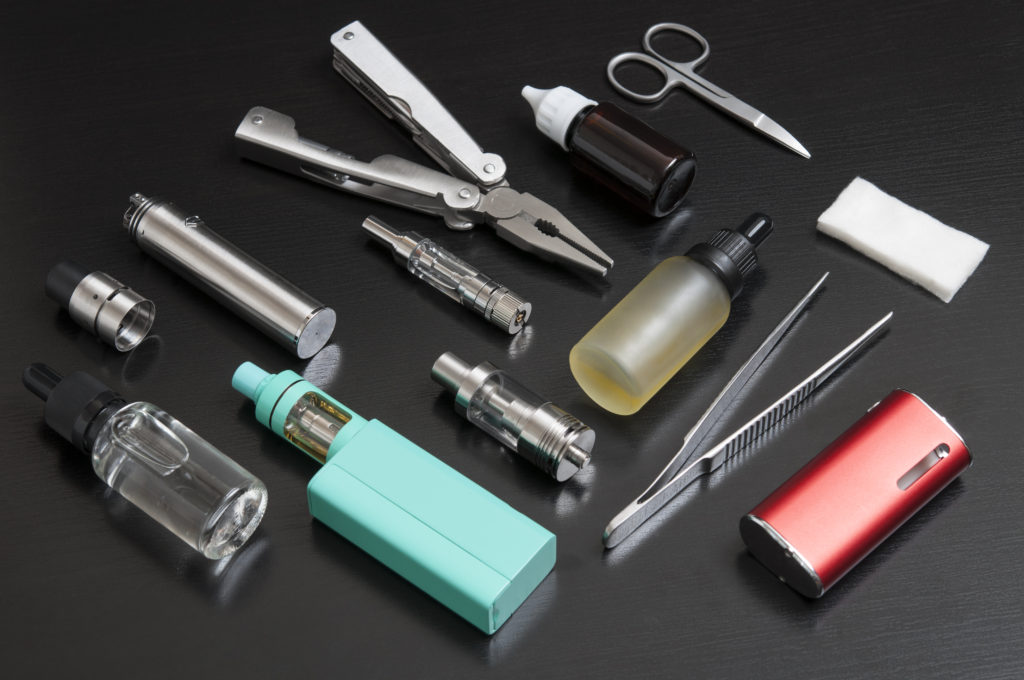You’ve got your new vape device, shiny, glassy. However, in two months, your device starts getting dirty, clogged and its performance drops…And you have just realized how important it is to keep a good maintenance of your vaping device.!
Regular maintenance is the key to long-term use and efficiency of your vaping device. In addition, keeping the components of your vape system clean ensures that you get the maximum flavor on each puff. To help you keep your vaping device as fresh as the day you bought it, we’ll give you some tips about “how to clean your vape tank”.
Structure of a Vaping Device

A vaping device consist of a tank and a battery. In addition, the tank consists of various parts: a coil, glass tube, top and bottom hardware and a drip tip.
The Battery: Most of vaping devices use lithium-ion batteries. The battery is the power unit of your vaping device. Some devices have power and temperature control modes for the battery. The battery is inside the housing.
The Tank: it’s where the e-liquid is held. Tanks have different capacities, with tanks of just 2 ml to tanks of 7 ml capacity or even more. The tank could be considered a unit with several parts:
- The Coil: it’s the heating element. It contains a wire or a mesh that is generally made of Kanthal or Nichrome and sometimes made of titanium, nickel or stainless steel.
- Drip Tips: Usually made on Delrin (a synthetic polymer), other plastics such as resin, stainless steel, aluminum, glass…
This is the basic structure of all vaping devices. Some devices are pod systems (with disposable pods) while others have refillable pods and tanks.
When to Clean your Vaping Device

In this blog we have talked about flavor ghosting and the importance to clean your vaping device to prevent it. Flavor ghosting happens when you experience previously used e-liquids. It could be avoided through a good maintenance of your vaping device.
If you want to prevent flavor ghosting, you should rinse and clean your vape tank each time you change e-liquid.
If you experience that the vaping device isn’t giving you the performance you expect, then you can clean each part of your device.
How to clean it: Steps
We can do a quick clean or a deep clean. For a quick clean, the steps are very simple, and we just need to follow some easy steps:
- Disassemble your device: do it so you can clean each piece individually. In other words, detach the tank from the mod and completely disassemble your tank.
- Dispose any e-juice remaining in the tank.
- Use a bowl with warm water or run warm water through the tank. If you use a bowl, you need to place all the pieces into the bowl. On the other hand, if you use running water, proceed to run warm water through the tank. You can do this process for approximately 30 seconds. This process will prevent e-liquids from forming deposits in the tank.
- For the next step you need paper towel to pull it through the tank. It’s simple, just take a piece of paper towel, twist it and pull the paper towel through the tank.
- Clean each of the pieces one by one. Use the paper towel to clean remaining deposits and use the paper towel to dry each piece. You can also use a clean toothbrush.
- Finally, you can use a hair dryer to completely dry all the piece before assembling them again.
Even if you change the coil there might be some flavor from previous e-liquids lingering in your vape tank. Avoid drying it under extreme heat or sunlight!
How to Clean Your Vape Tank: Deep Cleaning

Many sources recommend using a non-flavored vodka to clean each part of your device. For this process you need to:
- Detach all the tank parts and proceed to dispose all the remaining e-liquid.
- Non-flavored vodka is excellent to help break down any e-liquid deposits in your vape tank. You can also scrub with a piece of paper towel all the areas that still have e-liquid deposits.
- After you have used the non-flavored vodka to wipe all parts, proceed to use warm water to rinse all the pieces.
- You can let the piece stand on a paper towel or use a hair dryer to dry each piece.
- Finally, proceed to reassemble the tank and device.
Some source suggests using PG (Propylene glycol) to clean your tank. PG is a great flavor carrier and it’s an efficient method to clean your device from e-liquid deposits.
Obviously, you can also use other cleaning agents such as baking soda, vinegar (very acidic and excellent for cleaning but you need to rinse the tank thoroughly to get rid of vinegar smell) or ethanol. Ethanol is quite easy to find and very useful to clean your vape tank. In fact, you can use either non-flavored vodka or ethanol.
Vape Tank Cleaning: Conclusion
Some vapers don’t mind tasting a mixture of e-juices. As a matter of fact, some e-juices blend well, and the flavor is quite tasty. However, some mixtures aren’t probably the tastiest mixture. For example, you wouldn’t enjoy a mixture of coffee and menthol.
There are two options: you can either use different tanks for each e-liquid or do a vape tank cleaning before you use a new e-liquid.
The process is simple: warm water for a fast cleaning or ethanol (or non-flavored vodka) for a deep cleaning.
Finally, avoid soaking the piece in water overnight or boiling them as these processes can damage your tank.
This post was originally published on December 19, 2019. It was most recently updated on April 16, 2021.

![How to Clean Your Vape Tank Step by Step [Tutorial]](https://blog.aspirecig.com/wp-content/uploads/2019/12/47-1024x1024.jpg)
1 Comment
Pingback: Vaping vs Smoking Weed: Which Method is Better?